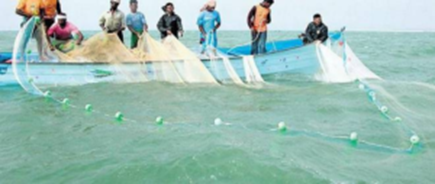Biology > Animal Husbandry > Fisheries and Pisciculture
Fishes are rich in protein, vitamins and mineral salts and are also known as valuable protective food. Fish forms an important item of the diet in many parts of the world. The development of fisheries is, therefore, one of the most promising industry. India has a coastline of about 8,129 km, 5 million km of the continental shelf and 2.02 million of an exclusive economic zone. India is a major marine fish producer and ranks seventh in the world.
The term fishery is used for catching, processing, fish farming and marketing of fish and other aquatic animals. The fishery includes fishes, prawns, lobsters, edible oysters, mussels, and crabs. Areas where fish are reared commercially, are known as artificial fisheries. The fishes are bred, reared and later harvested. The fishery may be a natural water body or an artificial one. A variety of fish may be reared together.
Types of Fisheries:
Depending on the nature of water in which fish is reared, fisheries are divided into three categories:
Marine Fisheries:

Marine fisheries include fishing operations along the sea coasts. The main varieties obtained in marine fisheries are Herpedon (Bombay duck बोंबील), rastrelliger (mackerels बांगडा), stromateus (pomfrets पापलेट), salmons, sardinella (sardines पडवा / वाशी /टारली), sharks (मुशी), and catfish (शिंगाडा).
Fresh Water Fisheries or inland Fisheries:

Freshwater fisheries include fish found in rivers, irrigation canals, reservoirs, lakes, dams, tanks, and ponds. The main varieties obtained in freshwater fisheries are carp fishes (labeo rohita (Rohu) तांबडा मासा, Catla काळा मासा, cirrhina (mirgala) मिऱ्या / मिरगा). Carp fishes are herbivorous. Catfishes (Mystus, Hilsa पाला, Bombay duck). Catfishes are carnivorous. Gourami, and Gambusia (omnivorous).
Estuarine or Brackish Water Fisheries:

They operate in estuaries (where river water and seawater get mixed), delta channels, backwaters, lagoons, and coastal lakes. Estuarine fish are more common in Bengal and Kerala. The tidal water collects the fish in the enclosures. The main varieties are Pearl spot, Milkfish, and Mullet.
Economic Importance of Fishes:
- Fish as food: Fish is a valuable and cheap source of food that is rich in proteins. Fish proteins are easily digestible.
- Medicinal use: Fish liver (shark liver and cod liver) oil is a natural source of vitamin A, C and Vitamin D.
- Industrial use: Body oils of sardines, herrings and salmons are used for the manufacture of edible oils and margarine. The oil obtained from fishes is used in soap, paint, and varnish industries.
- Feed for farm animals: Fish meal (dried fish) provides proteins to farm animals.
- Agricultural use: Fishes and fish wastes are used as organic manure in the fields.
- Adhesive: Skins and bones of fishes are also used in making high-quality glues and adhesives.
- Use of shark skin: Sharkskin is also used in the manufacture of handbags, wallets, shoes, etc. after tanning. Hide (leather) is also used to make parchment sheets. Sharkskin is abrasive and is called shagreen. It is used for smoothening surfaces for polishing.
- Generate employment: Fishery provides good job opportunity and self-employment for many people.
Commercial Fisheries:
Aquaculture:
Aquaculture involves the rearing and management of useful aquatic plant and animal resources such as fish and shellfish, (prawn, molluscs, crabs, etc.).It is also known as fish farming. Aquaculture provides employment to many people. Culturing certain fishes in ponds, lakes, and reservoirs is a common practice in most of the areas of the world, which boost the productivity and economy of the nation. China leads all countries in aquaculture production. In aquaculture, there is no requirement of nutrients from an outside source. The main aim is to obtain a number of economically important substances. Aquaculture is utilized for culturing pearls on a commercial scale
Pisciculture (Fish Farming):
It is concerned with the production of edible fish in lakes, rivers, large ponds, canals. In Pisciculture young fishes are reared in nursery ponds, transferred to lakes or rivers and finally harvested as fish for table food. Fish farms range from simple ponds or flooded rice fields to highly engineered hatcheries in which the environment is monitored and kept under control. It includes the removal of almost all possible harmful conditions. It helps fish to flourish and grow fast. Fishes are provided with proper nutrients as per a regulated plan. The main aim is to obtain a good yield for consumption as a food.
Pond culture (Kitchen Fisheries):
This involves culturing fish in small ponds. This practice is quite common in Bengal. Proper management is carried on till fish attains full size. They are also protected from diseases.
Molluscs Culture:
Mariculture is a specialized branch of aquaculture involving the cultivation of marine organisms for food and other products in the open ocean, an enclosed section of the ocean, or in tanks, ponds or raceways which are filled with seawater. Molluscs are usually cultivated in their natural habitat without any addition of feed. As filter-feeders, they contribute to water cleanness by removing sediments and unwanted nutrients. Molluscs comprising oysters, clams, mussels, squids, cuttlefish, octopus, etc. form important resources of food are cultivated by this method.
Examples: edible oyster (Crassostrea species), Mussels (Perna species), Clams (Meretrin species, Arca species, Donax species, Circa gibba, Solen species, cardium species), Cuttlefish (Sepia species), Squid (Loligo species). Octopus are all utilized as a food resource. Pearl oysters, the sacred ehank, Turbo, Trochus and windowpane oysters (Placenta placenta) are all of commercial importance.
Sea Weeds:
Seaweeds are used for human consumption as cattle and poultry feed, as manure and for industrial purpose as a source of agar-agar, and algin. Species of Gelidiella and Gracilaria (the red seaweeds) are the source for the manufacture of agar-agar. The brown seaweeds like Sargassum, Turbinaria Dictyota contains alginic acid. Ulva, Entromorphas, Caulerpa, Porphyra are varieties used in human food.
One reply on “Fisheries and Pisciculture”
Good info on fisheries in this article, thanks for the info!